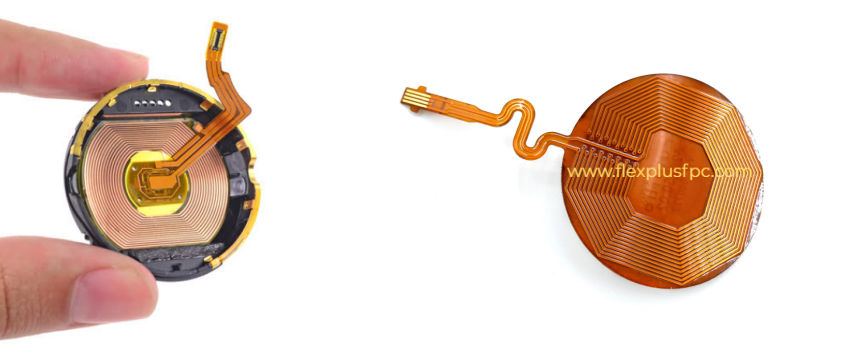Flexible circuit boards used in medical device
- Flex Plus Tech team
- Aug 19, 2024
- 4 min read
Updated: Mar 12
The application of flexible circuit boards in the medical field, especially in monitoring bracelets, proves its key role in medical devices and wearable technology. This paper summarizes the relevant information about the application of flexible circuit boards in the medical field.

Biosignal monitoring: They have different sensors for things like heart rate, oxygen saturation, blood pressure, skin temperature, and other needs on their bracelets so that they can monitor these biosignals in real time and help a user or medical personnel understand their health concerns.
These sensors must be arranged flexibly within the bracelet, while flexible circuit boards can accommodate complex circuit arrangements within a small space, thereby making it comfortable to wear around wrist curves. Thus, this makes flexible circuit boards one of the most important components of medical monitoring bracelets.
Data transmission and processing: The sensors are connected to processing chips as well as wireless communication modules by means of flexible circuit boards within the bracelet. It is possible to integrate various functional modules together due to multi-layer design while convenient routing enables efficient data transmission and processing.
Energy management: The power management system of the bracelet usually also relies on flexible circuit boards to connect the battery with various functional modules to ensure the low-power operation of the device. Flexible circuit boards can effectively manage current distribution and improve the endurance of the bracelet.
ECG monitoring: The application of flexible circuit boards in medical monitoring bracelets allows ECG monitoring equipment to fit the body better and provide accurate data, which is of great significance for the early detection and treatment of heart disease.
The application of flexible circuit boards in monitoring bracelets not only improves the accuracy and comfort of monitoring but also brings revolutionary changes to the medical field, heralding a new direction for future medical equipment and health management.
Advantages of Utilizing Flexible Circuit Boards In Applications

Flexibility: Because flexible circuit boards can conveniently adjust to the bending and twisting of a monitoring bracelet, these become more comfortable to wear without affecting the circuit’s intangibility and the reliability of its functions.
Thinness: The thinness of flexible circuit boards makes it possible to design smaller monitoring bracelets that reduce discomfort during wear and increase user acceptance.
High integration: High integration in flexible circuit boards enables more sensors and functions to be packed into a restricted area, which enhances the functionality and practicability of monitoring bracelets.
Other Applications of Flexible Circuit Boards in The Medical Field
Flexible circuit boards have other applications besides monitoring bracelets.
1. Wearable Medical Devices: This includes smart patches and electronic skin, which are typically required to be attached to the skin. These are designed with flexible printed circuits that make them conform closely to the surface of the skin while allowing for natural movement. It also facilitates telemedicine and health management concurrently.
2. Implantable medical devices, such as pacemakers and neuromodulators. The biocompatibility and durability of flexible circuit boards make them suitable for long-term implantation in the human body, ensuring the reliability and safety of the equipment.
3. Portable medical instruments: Some portable ultrasound equipment, blood glucose meters, etc., also use flexible circuit boards to reduce volume and weight and improve portability.
4. Medical equipment: Flexible circuit boards are also widely used in medical equipment, such as artificial joints. Their flexibility and durability are crucial to improving the performance of equipment and the quality of life of patients.
5. Hearing Aid Devices: Flex PCB designs enable the integration of a microphone, digital signal processing (DSP), and battery components into a compact unit that fits discreetly behind the ear.
6. Diagnostic tools: In medical imaging and laboratory diagnostic equipment, flexible circuit boards are used for signal transmission and control, improving the accuracy and efficiency of diagnosis.
7. Biomedical applications: Flexible circuit boards are also used to make micro-drug delivery systems and biomaterial scaffolders to provide personalized treatment for patients.
8. Telemedicine: Combined with 5G technology, flexible circuit boards will enable telemedicine, where doctors can monitor patients' health in real time and provide timely treatment recommendations.
Future Development Trend of Flexible PCB in The Medical Field
Technological innovation: With the progress of material science and nanotechnology, the material development and manufacturing process of flexible circuit boards will be significantly improved, making them more optimized in terms of flexibility, electrical conductivity, and high-temperature resistance.
Market demand growth: With the increasing aging of the global population and the increasing demand for medical health, the application demand of flexible circuit boards in medical monitoring, diagnosis, and treatment equipment will continue to grow.
Application field expansion: Flexible printed circuits will play a role in more medical devices and applications, such as implantable medical devices, wearable monitors, telemedicine devices, and so on.
Flexible PCBs are Combined With Other Technologies
Artificial Intelligence: The combination of flex circuit boards and artificial intelligence technology will enable medical devices to analyze and interpret data more intelligently, improving the accuracy of diagnosis and personalized treatment.
Internet of Things: Through the Internet of Things technology, flexible circuit boards will realize the interconnection between medical devices, providing patients with more comprehensive and continuous health monitoring and management.
The future development of flexible circuit boards in the medical field will greatly promote the progress of medical technology, improve the efficiency and quality of medical services, and bring more convenience and hope to patients.
Flex Plus has more than 20 years of experience in flex PCB production. We are committed to providing high-quality flex PCBs and rigid-flex PCBs to meet the different needs of different industries. If you need any information about flex PCB, please contact us.




Commentaires